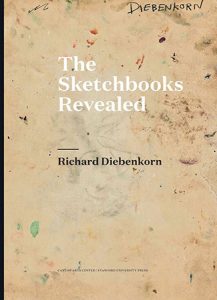Cantor Arts Center at Stanford spotlights Richard Diebenkorn’s sketchbooks
October 22, 2016
By Anna Koster

The exhibition, Richard Diebenkorn: The Sketchbooks Revealed, has been extended through Aug. 22, 2016, and all of the artist’s sketchbooks are online via a new website. An extensive catalog has been published by Stanford University Press.
For the very first time, the complete sketchbooks of the great American artist Richard Diebenkorn are available to view.
The Cantor Arts Center recently launched a new website that gives access to the museum’s collection of 29 sketchbooks by Richard Diebenkorn (1922–1993), a renowned artist celebrated as both a central figure in the Bay Area figurative movement and a key figure in the nationwide development of abstract expressionism and color-field painting.
The sketchbooks, a gift to the Cantor from the artist’s widow and long-time muse, Stanford alumna Phyllis Diebenkorn, ’42, as well as from the Diebenkorn Foundation, are presented in Richard Diebenkorn: The Sketchbooks Revealed, a major exhibition that has been extended through Aug. 22, 2016.
The sketchbooks contain 1,045 drawings dating from 1943 to 1993, all of which are available for viewing online.
Throughout his long career, Diebenkorn, AB ’49, kept a sketchbook – a “portable studio,” as he called it – to capture his ideas. These books, now in the Cantor’s collection, span 50 years and represent the range of styles and subjects he explored, including deeply personal portraits of his wife, studies of the figure, landscape studies and compositions that point to Diebenkorn’s signature blend of figuration and abstraction. Richard Diebenkorn: The Sketchbooks Revealed explores the relationship between his sketchbooks and his paintings, and includes loans of early works that Diebenkorn created as a Stanford student.
Touchscreens installed in the exhibition allow visitors to leaf through all 29 books digitally and see every drawing. That same digital catalog is now accessible for study online. With this remarkable resource, audiences near and far can examine all of the sketches in the order in which Diebenkorn laid them down on paper. When viewed in full, the sketchbooks provide new insights into how Diebenkorn experimented with line, shape, form and perspective as he creatively tackled challenging subjects.
“Presented together and in their entirety online, the sketchbooks become a revelation of sorts, offering intimate access to the practice of a well-known, important and prolific artist,” said Connie Wolf, the John and Jill Freidenrich Director of the Cantor Arts Center.
“Now they are accessible for study by students, scholars, artists, and the general public at any time. This extraordinary collection, on view both in the museum and through the launch of this website, combined with the show’s associated publication, offers an unprecedented opportunity to understand the artist’s process,” Wolf added.
The associated publication has more than 500 images from the sketchbooks, plus essays by Stanford-affiliated contributors.
Thanks to a gift from his late widow, Phyllis G. Diebenkorn, and a related donation from the Diebenkorn Foundation, the Cantor acquired in 2014 all of the artist’s sketchbooks, a matchless resource for understanding his approach to making art. Phyllis Diebenkorn, with the support of daughter Gretchen Diebenkorn Grant, AB ’67 and MFA ’69, and son-in-law Richard Grant, the executive director of the Diebenkorn Foundation, said she was thrilled to entrust the Cantor with this important collection.
The sketchbooks, which have never before been shown publicly or thoroughly studied, provide unique and invaluable insights into the artist’s creative and intellectual processes. With this gift, the Cantor is positioned as an essential resource for international scholarship on Diebenkorn. This gift will be the basis for scholarly projects and programing aimed at investigating the sketchbooks’ relation to the historic tradition of the artist’s sketchbook.